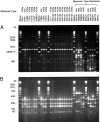A rare genotype of Cryptococcus gattii caused the cryptococcosis outbreak on Vancouver Island (British Columbia, Canada)
- PMID: 15572442
- PMCID: PMC535360
- DOI: 10.1073/pnas.0402981101
A rare genotype of Cryptococcus gattii caused the cryptococcosis outbreak on Vancouver Island (British Columbia, Canada)
Abstract
Cryptococcus gattii causes life-threatening infection of the pulmonary and central nervous systems in hosts with normal immunity and traditionally has been considered to be restricted geographically to tropical and subtropical climates. The recent outbreak of C. gattii in the temperate climate of Vancouver Island, BC, Canada, led to a collaborative investigation. The objectives of the current study were to ascertain the environmental source of the outbreak infections, survey the molecular types of the outbreak and environmental cryptococcal isolates, and determine the extent of genetic diversity among the isolates. PCR-fingerprinting and amplified fragment length polymorphism (AFLP) were used to examine the genotypes, and mating assays were performed to determine the mating type of the isolates. All outbreak and environmental isolates belonged to C. gattii. Concordant results were obtained by using PCR-fingerprinting and AFLP analysis. The vast majority of clinical and veterinary infections were caused by isolates of the molecular type VGII/AFLP6, but two were caused by molecular type VGI/AFLP4. All environmental isolates belonged to molecular type VGII/AFLP6. Two or three subtypes were observed within VGII/AFLP6 among outbreak and environmental isolates. All mating-competent isolates were of the alpha-mating type. The emergence of this usually tropical pathogen on Vancouver Island highlights the changing distribution of this genotype and emphasizes the importance of an ongoing collaborative effort to monitor the global epidemiology of this yeast.
Figures





References
-
- Kwon-Chung, K. J., Boekhout, T., Fell, J. W. & Diaz, M. (2002) Taxon 51, 804–806.
-
- Kwon-Chung, K .J. & Bennett, J.E. (1984) Am. J. Epidemiol. 120, 123–130. - PubMed
-
- Sorrell, T. C. (2001) Med. Mycol. 39, 155–168. - PubMed
-
- Hoang, L. M. N., Maguire, J. A., Doyle, P., Fyfe, M. & Roscoe, D. L. (2004) J. Med. Microbiol. 53, 935–940. - PubMed
Publication types
MeSH terms
LinkOut - more resources
Full Text Sources
Other Literature Sources

